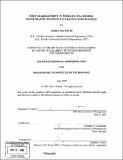| dc.contributor.advisor | Michael A. Cusumano. | en_US |
| dc.contributor.author | Matsuki, Akira | en_US |
| dc.contributor.other | Sloan School of Management. | en_US |
| dc.date.accessioned | 2006-07-31T15:11:44Z | |
| dc.date.available | 2006-07-31T15:11:44Z | |
| dc.date.copyright | 2005 | en_US |
| dc.date.issued | 2005 | en_US |
| dc.identifier.uri | http://hdl.handle.net/1721.1/33549 | |
| dc.description | Thesis (M.B.A.)--Massachusetts Institute of Technology, Sloan School of Management, 2005. | en_US |
| dc.description | Includes bibliographical references (leaf 100). | en_US |
| dc.description.abstract | The mobile communication industry in Japan is facing a constructive revolution that will be the industry to next-generation services. Most communication companies have competed aggressively to develop and offer e-mail or Web applications to their users in order to increase operating revenue. One approach was the introduction of flat rate plans, used primarily to acquire new customers; however, the profits achieved by relying on communication fees are diminishing. Nevertheless, mobile phones continue to be the point of contact closest to the customer. In recent years, mobile phones have evolved from tools used primarily for talking to a tool that transmits and receives e-mail. But these are changes that alter the quality of communication rather than make a substantial change. To heighten its competitive position, in June 2004, NTT DoCoMo developed a new type of cellular phone that contains a built-in noncontact IC card called "FeliCa," which represents the next remarkable stage of progress. This thesis first analyzes the structural transformation of the mobile phone business, and then discusses how it is influencing the financial and authentication businesses. First I present an overview of the mobile communication industry, showing its progress from a rapid growth to a mature market. Next, I show how wireless carriers are building a new wireless value chain by implementing the IC card function in mobile phone terminals. Then I describe the new wireless value chain and offer examples that illustrate the kinds of change that have been created in the industry structure. I conclude by describing a business strategy that utilizes the new platform, and the influence that the new platform will have on society. | en_US |
| dc.description.statementofresponsibility | by Akira Matsuki. | en_US |
| dc.format.extent | 100 leaves | en_US |
| dc.format.extent | 4984259 bytes | |
| dc.format.extent | 4988403 bytes | |
| dc.format.mimetype | application/pdf | |
| dc.format.mimetype | application/pdf | |
| dc.language.iso | eng | en_US |
| dc.publisher | Massachusetts Institute of Technology | en_US |
| dc.rights | M.I.T. theses are protected by copyright. They may be viewed from this source for any purpose, but reproduction or distribution in any format is prohibited without written permission. See provided URL for inquiries about permission. | en_US |
| dc.rights.uri | http://dspace.mit.edu/handle/1721.1/7582 | |
| dc.subject | Sloan School of Management. | en_US |
| dc.title | The paradigm shift in wireless platforms : from traffic business to transaction business | en_US |
| dc.type | Thesis | en_US |
| dc.description.degree | M.B.A. | en_US |
| dc.contributor.department | Sloan School of Management | |
| dc.identifier.oclc | 63201490 | en_US |
